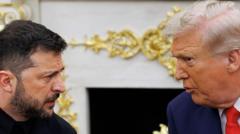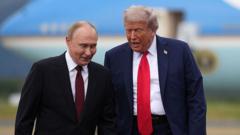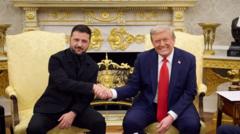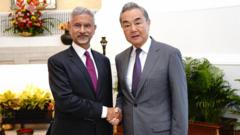The Oval Office map emphasizing Russian-occupied territories has played a pivotal role in shaping President Trump's stance on the Ukraine war, illustrating contrasting perspectives with Ukrainian President Zelensky during their recent talks.
The Influence of Maps in Shaping U.S. Perspectives on the Ukraine Conflict
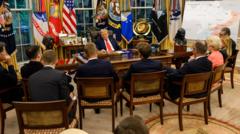
The Influence of Maps in Shaping U.S. Perspectives on the Ukraine Conflict
The strategic use of maps in discussions between Trump and Zelensky highlights differing views on Ukrainian territorial integrity amidst ongoing conflicts.
The map displayed in the Oval Office, depicting areas of Ukraine under Russian control, has significantly influenced former President Donald Trump's discussions regarding the ongoing conflict with Ukrainian President Volodymyr Zelensky. The map, featuring regions shaded in red, symbolically underscored the substantial extent of Russian occupation—approximately one-fifth of Ukrainian territory—during their meeting. Trump referenced this visual aid while speaking to Fox News, indicating that the territorial losses were undeniable and suggesting that a territorial compromise might be worth considering with Russia.
In contrast, Zelensky arrived at the discussion equipped with a different map, emphasizing real control dynamics in the conflict. He indicated that he was "fighting with what is on that map" to clarify the true state of territorial control, expressing concern over the perception of strength held by Russian forces. Trump's assertion that Russian capabilities appeared "much more powerful" reflected a viewpoint that seems to lean towards accepting territorial concessions.
The issue of potential land swaps became a focal point, as discussions emerged regarding the Donbas region, now overwhelmingly under Russian control. The disparity in territorial claims demonstrated through maps led to critical debates during the meeting, with Zelensky asserting that only a fraction of Ukrainian territory had been lost in the past thousand days, contesting the narrative presented by the U.S. administration.
Compounding the intricacies of this dialogue, reports indicated that while Russia has achieved some recent operational successes, gaining full control of regions like Donetsk would likely take years. Nonetheless, as both leaders exchanged perspectives grounded in their respective maps, the discussion underscored vastly different interpretations of the situation.
Despite the contrasting viewpoints and strategic assessments regarding the war, Zelensky acknowledged the value of the Oval Office map, perhaps seeing it as an opportunity to reaffirm Ukraine's position while contemplating how to reclaim lost territory. In the complex landscape of the Ukraine conflict, these visual representations play a critical role in influencing the dialogues and decisions made at the highest levels of government.

